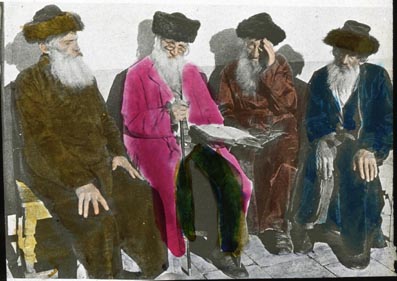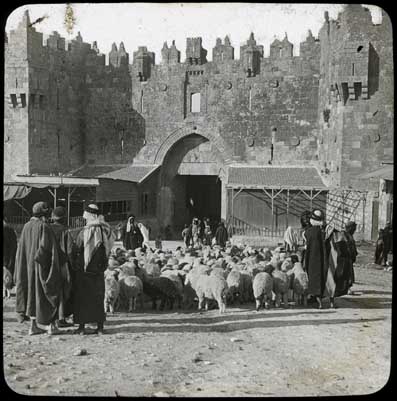
The Damascus Gate, Jerusalem.
The Damascus Gate (or in Arabic 'Bap-el-Amud' which means 'Column Gate'), is an important gate in the old city of Jerusalem. A gate had been built here in the second temple times, being replaced with a triple arched gate in the time of the Roman Emperor Hadrian in 135 A.D. The Romans erected a victory column in front of the gate, thus giving the gate its Arabic name. Being the northern gate to the city at the time of the Crusades, it was again replaced by the Ottoman Ruler Suleiman the Magnificent in 1542. It is this gate that survives today although excavations have located the foundations of the Roman gate.
The site of the Pool of Bethesda in Jerusalem (also known as the Sheep's Pool) located just north of the Temple Mount. A pool in Jerusalem called Bethesda and located near the Sheep Gate is described in the Gospel of John. Until the 19th century and archeological work, there was no evidence outside of John's Gospel for the existence of this pool.
"Now there is in Jerusalem by the Sheep Gate a pool, in Hebrew called Beth-za-tha, which has five porticoes. In those days lay a multitude of invalids, blind, lame, paralysed. One man was there, who had been ill for thirty-eight years. When Jesus saw him and knew that he had been lying there a long time, he said to him, "Do you want to be healed?" The sick man answered him, "Sir, I have no man to put me into the pool when the water is troubled, and while I am going another steps down before me." Jesus said to him, "Rise, take up your pallet, and walk." And at once the man was healed, and he took up his pallet and walked." [John 5:2-9]
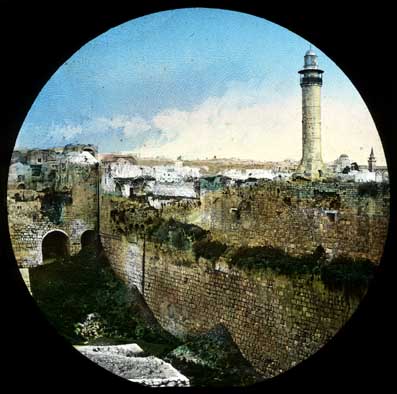
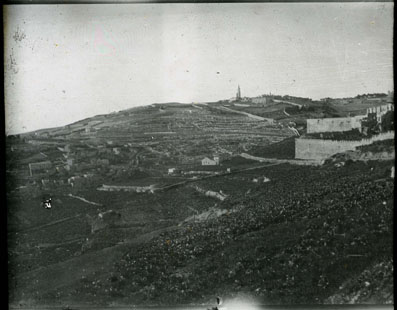
The Mount of Olives and Jewish Cemetery
Taken looking across the Kidron Valley from Jerusalem, the Jewish Cemetery covers much of the hillside on the Mount of Olives in the distance. Jesus returned here with his disciples after the Last Supper on the night of his betrayal.
"And after they had sung a hymn, they wentout to the Mount of Olives. Then Jesus said to them, "You will all fall away because of me this night; for it is written, "I will strike the shepherd, and the sheep of the flock will be scattered." But after I am raised up, I will go before you to Galilee. Peter declared to him, "Though they all fall away because of you, I will never fail you." Jesus said to him, "Truly, I say to you, this very night, before the cock crows, you will deny me three times. Peter said to him, "Even if I must die with you, I will not deny you". And so said all the disciples." [Matthew 26:30-35]
Olive Trees in The Garden of Gethsemane
Jesus often came here with his disciples, notably after the Last Supper when he was betrayed by Judas.
"Then Jesus went with them to a place called Gethsemane, and he said to his disciples, "Sit here, while I go yonder and pray.... Then he came to his disciples and said to them, "Are you still sleeping and taking your rest? Behold, the hour is at hand, and the Son of man is betrayed into the hands of sinners. Rise, let us be going; see my betrayer is at hand." [Matthew 26:36-46]
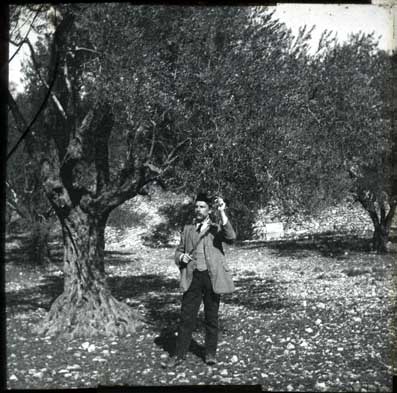
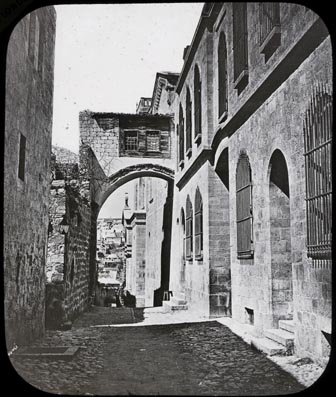
The "Ecce Homo" Arch, Jerusalem
Located on the Via Dolorosa, this archway is along the route that Jesus is traditionally believed to have carried the cross prior to being crucified at Golgotha [Calvary]. The archway is located between the second and third 'stations of the cross'.The arch is actually part of a larger triumphal arch built by Emperor Hadrian in 135A.D. The left arch no longer exists and part of the remaining arch is preserved inside the Convent of the Sisters of Zion, shown at right in the image. The Church also preserves interesting vestiges of the Roman era street paving, the so-called 'Lithostratus'.
"Now the chief priests and the elders persuaded the people to ask for Barabbas and destroy Jesus. The governor again said to them, "Which of the two do you want me to release for you?" And they said, "Barabbas". Pilate said to them, "Then what shall I do with Jesus who is called Christ?" They all said, "Let him be crucified." And he said, "What evil has he done?" But they shouted all the more, "Let him be crucified." [Matthew 27:20-23]
The Church of the Holy Sepulchre, Jerusalem
This church is built on what is believed by Christians to be Golgotha, the Rock of Calvary, where the New Testament states Jesus was crucified. After a temple of Venus had been constructed on the site, Emperor Constantine had a church built on this site about 325-326 A.D. Rebuilding and restoration has taken place right up to the present day. An important pilgrimage destination, the Church also contains the sepulchre where Jesus was believed to have been buried prior to the resurrection.
"Then the soldiers of the governor took Jesus into the praetorium, and they gathered the whole batallion before him. And they stripped him and put a scarlet robe upon him, and plaiting a crown of thorns they put it on his head, and put a reed in his right hand. And kneeling before him they mocked him saying, "Hail, King of the Jews!" And they spat upon him, and took the reed and struck him on the head. And when they had mocked him, they stripped him of the robe, and put his own clothes on him, and led him away to crucify him." [Matthew 27:27-31]
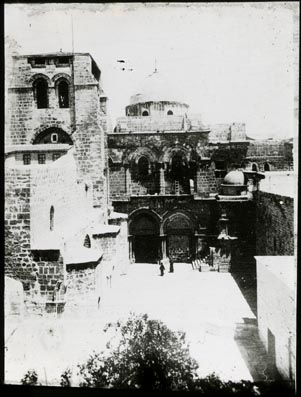
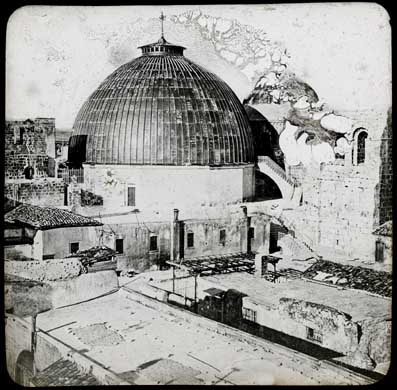
The Dome of Church of the Holy Sepulchre
Located within the old City of Jerusalem, the church is built over what has been traditionally assumed to be the site of the tomb of Jesus and the scene of the resurrection. The current dome dates from 1870 and restored in 1994-97.
"So they took Jesus, and he went out, bearing his own cross, to the place called the place of a skull, which is called in Hebrew Golgotha. There they crucified him, and with him two others, one on either side, and Jesus between." [John 19:17-18]
The Stone of the Anointing in the Church of the Holy Sepulchre
Just inside the entrance to the Church of the Holy Sepulchre in Jerusalem is the 'Stone of Anointing', traditionally believed to be the spot where Jesus' body was prepared for burial. This is also referred to as the 13th Station of the Cross.
"When it was evening, there came a rich man from Arimathea, named Joseph, who also was a disciple of Jesus. He went to Pilate and asked for the body of Jesus. Then Pilate ordered it to be given to him. And Joseph took the body, and wrapped it in a clean linen shroud, and laid it in his own new tomb, which he had hewn in the rock; and he rolled a great stone to the door of the tomb, and departed." [Matthew 27:57-60]
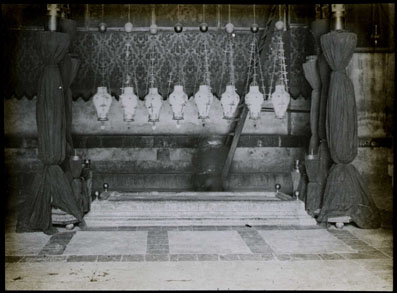
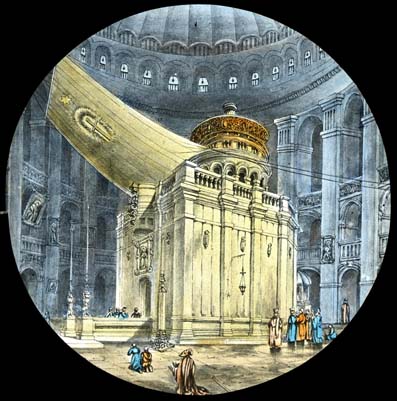
The 'Edicule' in the Church of the Holy Sepulchre
An old tinted lantern slide picture of the 'edicule' within the Church of the Holy Sepulchre, Jerusalem. Surrounded by a colonnaded atrium and covered with a dome, the 'edicule' contains the remains of the cave within the Rock of Calvary that Helena and Macarius had identified as the burial site of Jesus prior to the resurrection. The surrounding rock was later cut away, and the former tomb encased in the 'edicule' which remains inside the church to this day.
"Now after the sabbath, toward the dawn of the first day of the week, Mary Magadalene and the other Mary went to see the sepulchre. And behold, there was a great earthquake; for an angel of the Lord descended from heaven and came and rolled back the stone, and sat upon it. His appearance was like lightening, and his raiment white as snow. And for fear of him the guards trembled and became like dead men. But the angel said to the women, "Do not be afraid; for I know that you seek Jesus who was crucified. He is not here; for he has risen, as he said." [Matthew 28:1-6]
Jerusalem from Mount Zion, showing the Dome of the Rock (GWW slide)
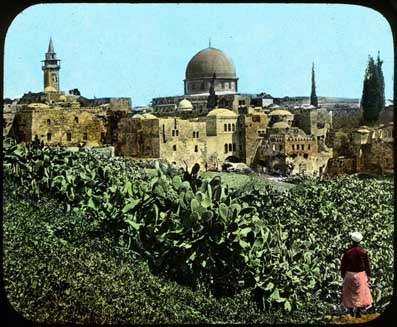
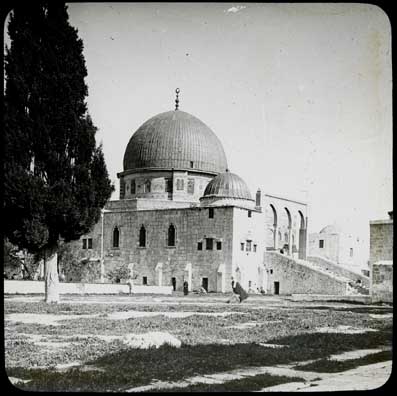
The Dome of the Rock on the Temple Mount, Jerusalem
Built on Herod the Great's man-made platform of Temple Mount by Caliph Abd al-Malik about 691 A.D., it is now the oldest extant Islamic building in the world.Although intially built as a shrine for pilgrims, it later became a mosque. The Dome of the Rock is considered the second holiest site in Islam after the Kaaba at Mecca. Its significance stems from the belief that the rock upon which it is built is the place from where Mohammad ascended to heaven accompanied by the angel Gabriel.
"Every where about the Mosque of Omar are portions of pillars, curiously wrought altars, and fragments of elegantly carved marble - precious remains of Solomon's Temple. These have been dug from all depths in the soil and rubbish of Mount Moriah, and the Moslems have always shown a disposition to preserve them with the utmost care."From "The Innocents Abroad" by Mark Twain, 1869.
